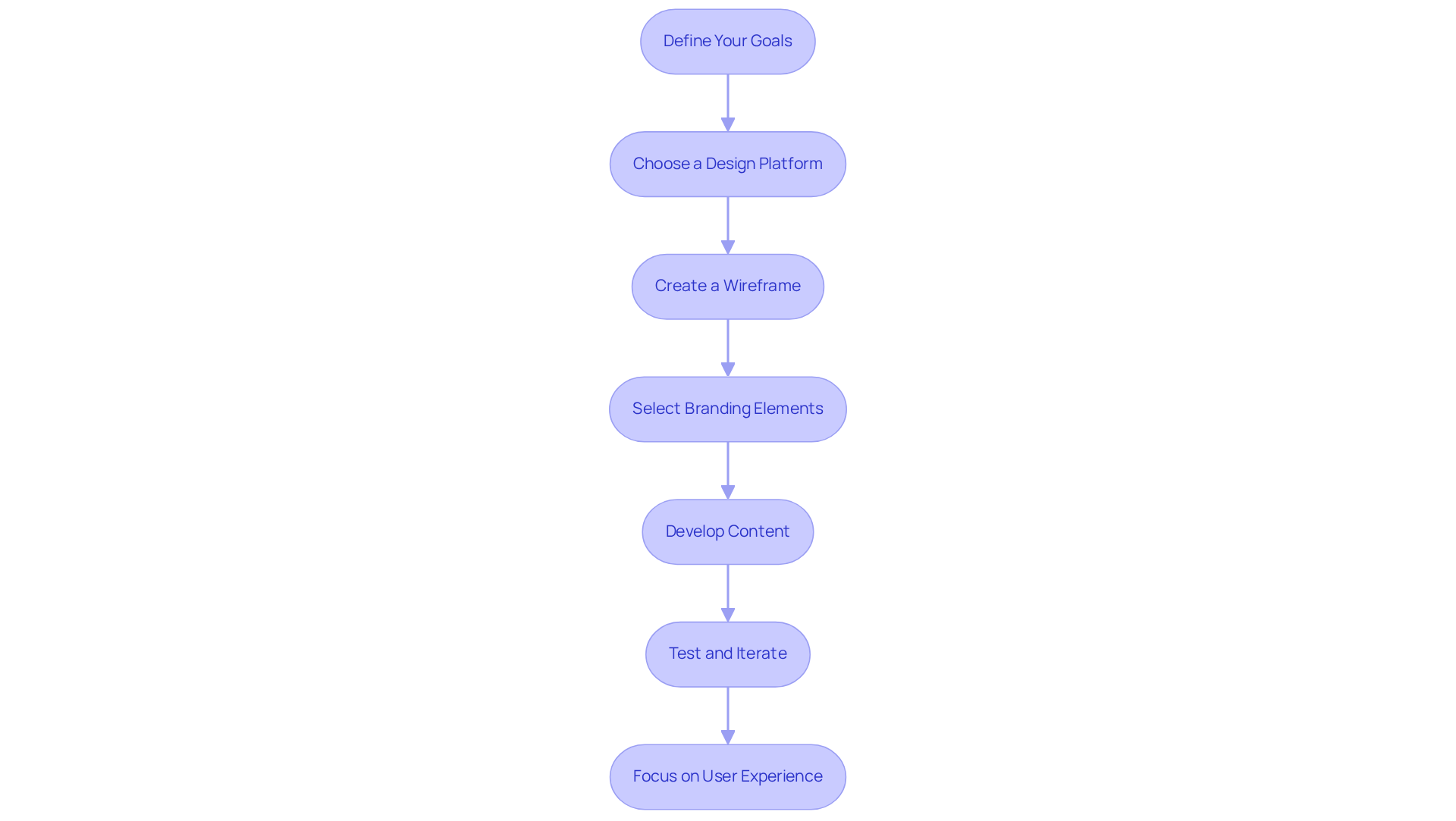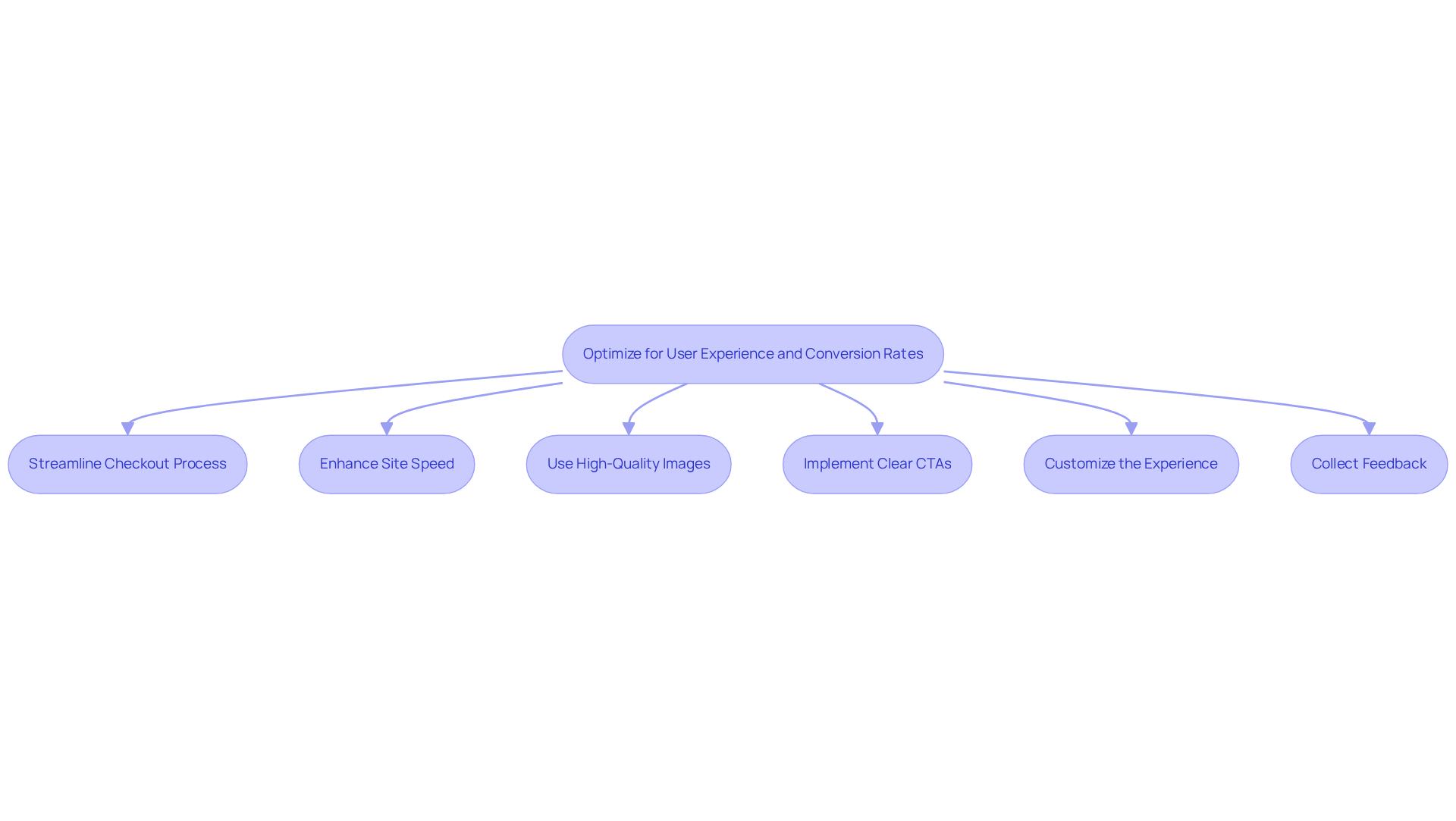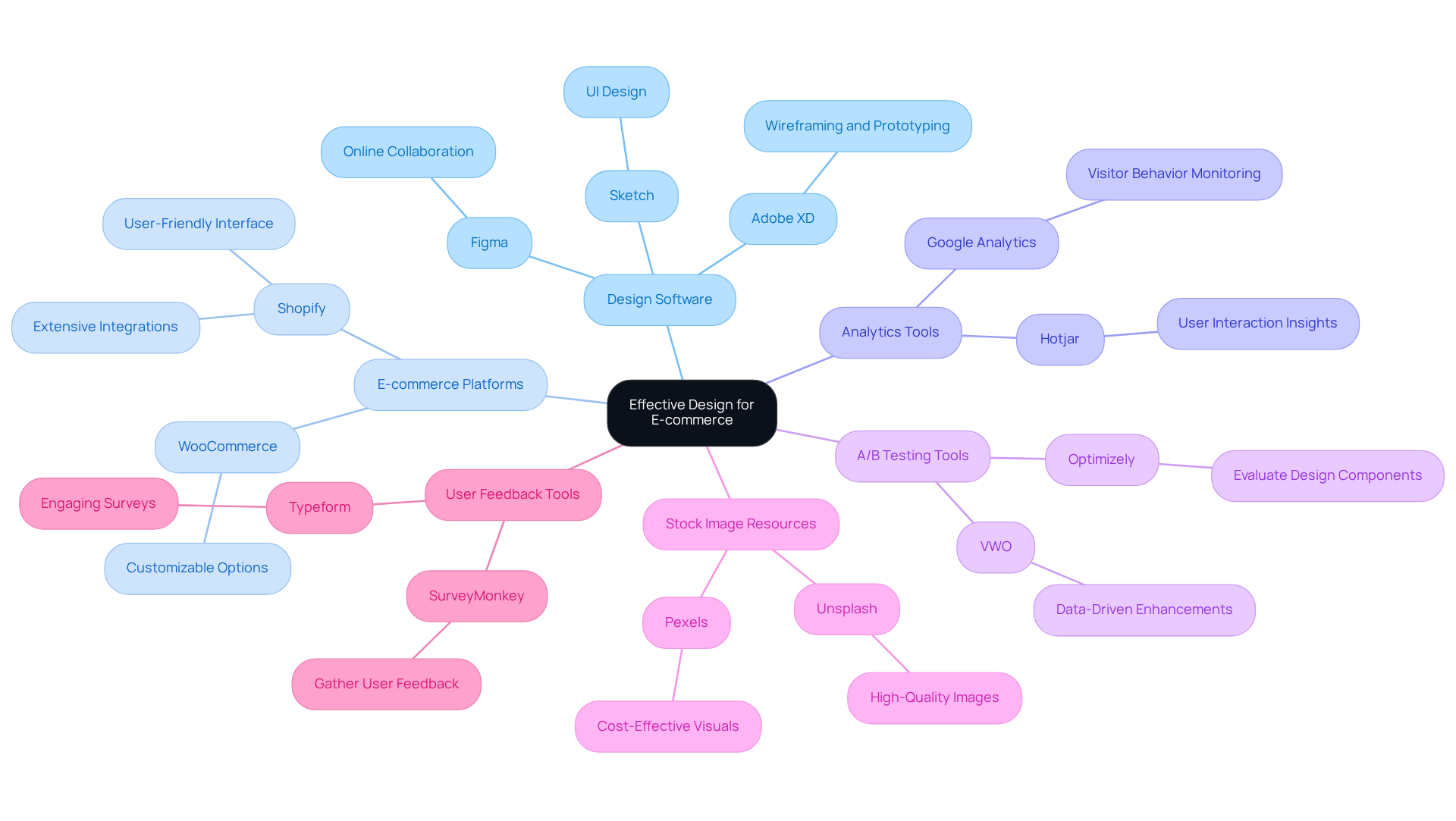
Overview
This article delineates four pivotal steps for crafting an effective e-commerce site tailored for direct-to-consumer (DTC) brands. It emphasizes:
- User-centric design
- Strategic planning
- Optimization for user experience
- The utilization of appropriate tools and resources
Understanding customer needs is paramount; thus, creating a seamless navigation experience is essential. Additionally, leveraging analytics for continuous improvement is crucial. By providing a comprehensive framework, this article aims to enhance site effectiveness and significantly boost conversion rates.
Introduction
Crafting an effective e-commerce site is no longer merely an option; it has become a necessity for direct-to-consumer (DTC) brands aiming to thrive in an increasingly competitive landscape. The rapid growth of online shopping compels brands not only to attract customers but also to deliver a seamless and engaging shopping experience.
This article explores the essential steps and best practices for designing a successful e-commerce site, encompassing:
- User-centric design
- Optimization for conversion rates
As the digital marketplace evolves, brands must leverage these insights to distinguish themselves and enhance customer satisfaction.
Understand E-Commerce Site Design Fundamentals
To design an effective e-commerce site, understanding the following fundamentals is essential:
- : Prioritizing the needs and preferences of your target audience is crucial. Conducting thorough research to identify pain points and preferences is imperative. As industry experts highlight, today’s consumers are increasingly selective, opting for brands that resonate with their values.
- Visual Hierarchy: Organizing content strategically guides users' attention to the most critical elements, including calls to action (CTAs) and product images. Successful online retail platforms that design site e commerce, exemplified by leading brands, leverage a robust visual hierarchy to cultivate engaging and intuitive shopping experiences. Retailers can observe marked improvements in bounce rates when their pages load in under three seconds, underscoring the significance of a well-structured visual hierarchy.
- Ensuring your design site e commerce is mobile-friendly is non-negotiable, given that a substantial portion of e-commerce traffic originates from mobile devices. Implementing flexible layouts and scalable images is vital for delivering a seamless experience across all devices.
- Crafting intuitive navigation on the design site e commerce is essential for enabling users to locate products effortlessly. Clear categories and subcategories enhance discoverability, making the shopping experience more enjoyable.
- Trust Signals: Incorporating elements that foster trust, such as customer reviews, secure payment options, and transparent return policies, is critical. These factors significantly influence purchasing decisions. By visually prioritizing these trust signals, their effectiveness and impact on conversion rates can be markedly enhanced.

Follow a Step-by-Step Design Process
To design your e-commerce site effectively, it is imperative to follow these strategic steps:
- Define Your Goals: Establish clear objectives for your e-commerce platform, such as increasing sales by 10% within six months or enhancing visitor engagement. SMART goals are essential for guiding your strategy and measuring success.
- Choose a design site e commerce platform that matches your business needs and budget. Popular options like Shopify, WooCommerce, and BigCommerce dominate the market, with Shopify holding a significant share due to its user-friendly interface and extensive features. Consider the platform's scalability and integration capabilities to support future growth.
- Create a wireframe for your design site e commerce by sketching a basic layout of your site, including key pages like the homepage, product pages, and checkout process. This visual representation assists you in mapping out the journey of the individual and ensures a seamless experience.
- When creating a design site e commerce, choose a color scheme, typography, and imagery that reflect your brand identity. Consistency across all pages boosts brand recognition and customer trust.
- Develop Content: Craft compelling product descriptions and engaging visuals that resonate with your audience. High-quality content is crucial for attracting traffic and improving search engine rankings, as evidenced by case studies showing that effective content strategies can significantly boost engagement.
- Test and Iterate: Launch a beta version of your platform and collect feedback from individuals. Implement A/B testing to refine design elements based on visitor interactions, ensuring that your site evolves to meet customer needs. Ongoing optimization and performance monitoring are vital for maintaining a competitive edge.
As we look ahead to 2025, the online retail environment is becoming increasingly competitive, with mobile transactions anticipated to hit 43.4% by the conclusion of 2023. Therefore, prioritizing is vital for success. As Joe Hitchcock points out, "Creating a lucrative online shop requires time," highlighting the necessity for patience and ongoing enhancement in your online business journey. Furthermore, concentrating on customer satisfaction and retention strategies will further improve your online business success.

Optimize for User Experience and Conversion Rates
To optimize your e-commerce site for user experience and conversion rates, implement the following strategies:
- Streamline the Checkout Process: Minimize the number of steps required to complete a purchase. Offering guest checkout options and clearly displaying progress indicators can significantly reduce cart abandonment, which is a common issue with rates as high as 68.7% in the US and 69% globally.
- Enhance Site Speed: Fast loading times are crucial; a delay of just one second can lead to a 7% reduction in conversions. Ensure your webpage loads quickly by optimizing images, leveraging browser caching, and utilizing content delivery networks (CDNs). Google recommends a page load speed of less than two seconds to minimize bounce rates, which can triple if a page takes more than three seconds to load. Furthermore, the typical retail website has 350 accessibility problems per page, which can impede performance and overall experience.
- Use High-Quality Images: Invest in professional product photography. High-quality images enhance perceived value and can lead to increased purchases, as they provide customers with a clearer understanding of the product.
- Implement Clear CTAs: Use prominent and persuasive calls to action throughout your site. Ensure they stand out visually and use action-oriented language to guide individuals effectively through the purchasing process. As Bernard Meyer states, 'Continually optimizing your design site e commerce checkout is important if you want to make more sales.'
- Customize the Experience: Utilize data analytics to provide tailored suggestions based on individual behavior. This customized approach can enhance engagement and conversion rates, as 71% of customers anticipate a personalized shopping journey.
- Collect Feedback: Regularly seek input from participants to identify areas for enhancement. Utilize surveys and to enhance the interaction, ensuring that your platform meets client expectations and addresses any pain areas. Keep in mind, 98% of individuals abandon their purchase without making any due to experience issues, emphasizing the significance of ongoing enhancement.

Utilize Tools and Resources for Effective Design
To elevate your e-commerce site design, leverage the following tools and resources:
- Design Software: Utilize tools like Adobe XD, Figma, and Sketch to efficiently create wireframes and prototypes. Figma, in particular, stands out for its online collaboration features, making it ideal for teams.
- Consider e-commerce platforms such as Shopify and WooCommerce, which offer built-in templates and features that help you design site e commerce efficiently. Shopify is especially popular for its extensive integrations and user-friendly interface, catering to businesses anticipating rapid growth.
- Analytics Tools: Implement Google Analytics and Hotjar to monitor visitor behavior and gain insights into interactions with your site. These tools are essential for understanding customer preferences and improving the client experience. Notably, 13% of customers will abandon their carts if they don’t see enough payment methods available, underscoring the importance of comprehensive analytics.
- A/B Testing Tools: Utilize platforms such as Optimizely and VWO to evaluate different design components and enhance conversions based on actual participant data. This data-driven approach is crucial for improving site performance and increasing conversion rates.
- Stock Image Resources: Access high-quality images from websites like Unsplash and Pexels to enhance your product listings without incurring high photography costs. Visual appeal is vital, as studies show that over 70% of shoppers are willing to pay more for , and over 50% of people make a purchase after reading a company’s blog post, emphasizing the importance of effective imagery and content.
- User Feedback Tools: Employ tools like SurveyMonkey and Typeform to gather user feedback, informing design improvements and boosting user satisfaction. Engaging with customers directly can provide invaluable insights into their needs and preferences, ultimately driving loyalty and repeat business. As Annie Laukaitis notes, customer feedback can be a goldmine of insights that can guide your decision-making on adopting new trends.

Conclusion
Crafting a successful e-commerce site for direct-to-consumer (DTC) brands is fundamentally rooted in a deep understanding of key design principles and strategies. A user-centric approach, coupled with a robust visual hierarchy and mobile-friendly design, establishes the foundation for an engaging shopping experience. By prioritizing intuitive navigation and incorporating trust signals, brands can effectively guide consumers through their purchasing journey, ultimately fostering loyalty and enhancing conversion rates.
This article delineates essential steps for designing an effective e-commerce site, ranging from:
- Defining clear goals
- Selecting the right platform
- Creating a cohesive brand identity
- Optimizing user experience
It underscores the importance of:
- Streamlining the checkout process
- Enhancing site speed
- Utilizing high-quality imagery to capture consumer interest
Furthermore, leveraging tools and resources such as analytics and A/B testing can yield valuable insights, ensuring that the site evolves in response to user feedback and shifting market dynamics.
As the e-commerce landscape continues to expand and evolve, brands must remain adaptable and committed to enhancing user experiences. Embracing best practices in site design not only improves conversion rates but also establishes a strong connection with consumers. By focusing on user satisfaction and continuously optimizing the online shopping journey, DTC brands can strategically position themselves for long-term success in an increasingly competitive environment.
Frequently Asked Questions
What is user-centric design in e-commerce site design?
User-centric design prioritizes the needs and preferences of the target audience by conducting thorough research to identify their pain points and preferences. It is crucial for resonating with consumers who are increasingly selective about brands.
Why is visual hierarchy important in e-commerce design?
Visual hierarchy organizes content strategically to guide users' attention to the most critical elements, like calls to action (CTAs) and product images. A well-structured visual hierarchy can improve user engagement and reduce bounce rates, especially when pages load quickly.
How can e-commerce sites ensure they are mobile-friendly?
E-commerce sites can ensure mobile-friendliness by implementing flexible layouts and scalable images, which provide a seamless experience for users accessing the site from various mobile devices.
What role does navigation play in e-commerce site design?
Intuitive navigation is essential for enabling users to locate products easily. Clear categories and subcategories enhance discoverability, making the shopping experience more enjoyable for customers.
What are trust signals, and why are they important in e-commerce?
Trust signals are elements that foster consumer confidence, such as customer reviews, secure payment options, and transparent return policies. They significantly influence purchasing decisions, and visually prioritizing these signals can enhance their effectiveness and impact on conversion rates.
FAQs











